Don’t want to deal with soil contamination? Have you ever attempted to start a garden indoors? Because the amount of space you can use to grow plants may be limited, you must learn how to maximize your available space. Growing vegetables indoors has never been easier than with hydroponics.
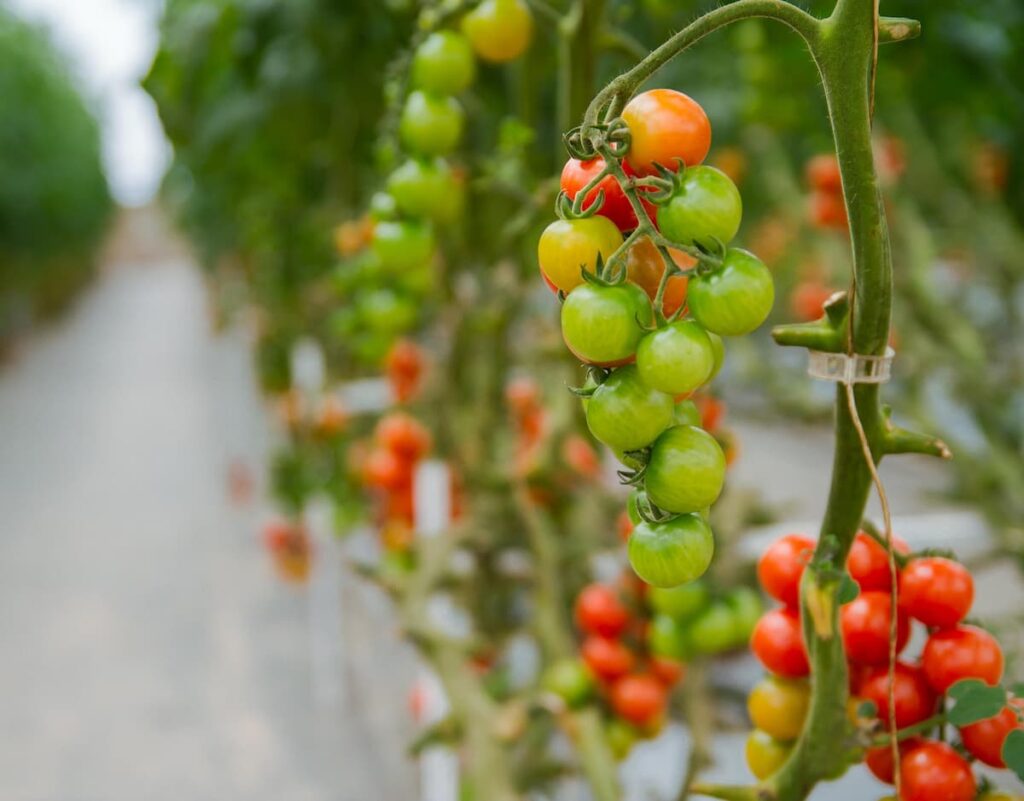
The practice of growing plants without soil by using nutrient solutions in water is known as hydroponics. This form of farming is highly-efficient, allowing you to grow vegetables indoors with minimal space and resources. In addition, hydroponics is an easy and rewarding way to grow vegetables indoors.
How to grow hydroponic vegetables indoors
Introduction to Hydroponics
Hydroponic gardening is the best way to grow plants without soil. Hydroponics is the most convenient way to grow vegetables indoors without soil. It is a quick, modern, and inexpensive way of growing year-round. With hydroponics, nutrient-filled water is used to feed the plants, eliminating the need for soil. This process is fast and requires less water and space than a traditional garden.
In hydroponic system is one in which plants get all their nutrients directly from the water. Instead of soil, a growing medium such as pebbles is used to keep the hydroponic plants upright. The water is enriched with nutrients and occasionally oxygen to allow the plants to grow. Although hydroponic gardening requires some management, you can learn how to grow hydroponic vegetables indoors with the right tips and tricks.
With this article, you will learn about the benefits of hydroponics, how to set up and maintain your own hydroponic garden, and how to select suitable vegetables to grow. This is an innovative method of growing plants inside and outside the home. However, this simple routine is manageable even for a beginner.
A step-by-step guide to growing vegetables in Hydroponics Indoor
You can quickly grow the vegetables you want with the help of hydroponics growing systems without having to worry about the outdoor environment or soil problems. However, to achieve a good result, you must provide plenty of lighting for your indoor hydroponic garden. Here are some tips for keeping your vegetable garden healthy with minimal effort. The roots of plants are grown in a nutrient-rich water solution in hydroponics to absorb essential nutrients from it. Plants grown in water-filled hydroponic systems have fewer chances of causing problems, so less water is required to grow them.
- When planning your own hydroponic indoor vegetable garden, consider the required types of containers available for hydroponic growing.
- Use rock wool as a growing medium because it provides a good balance of water and oxygen to the roots. It also promotes healthy plant growth at each stage.
- The proper amount of hydroponic nutrients for your vegetable garden is critical for plant growth. Therefore, you must understand your plants’ nutrient requirements and provide a well-mixed nutrient solution accordingly.
- Hydroponic indoor vegetable gardens require a lot of light to grow. The type of lighting you require is determined by the plants you are growing and the available space.
- To create an ideal environment for indoor vegetable growth, try to keep the grow room temperature and humidity level stable.
- Even if you live in an environment unsuitable for plant growth, hydroponics systems allow you to grow plants.
- Hydroponic vegetables are nutritious, energetic, and dependable. It’s a clean and simple method of gardening. Vegetables grow an extensive root system to search for food and water in traditional gardening, but in hydroponics, Nutrients and water are fed directly to the root system. This allows the plants to grow twice as fast.
In case you missed it: How to Maintain the pH Levels of Hydroponic Systems: Increase, Decrease, and Stabilize
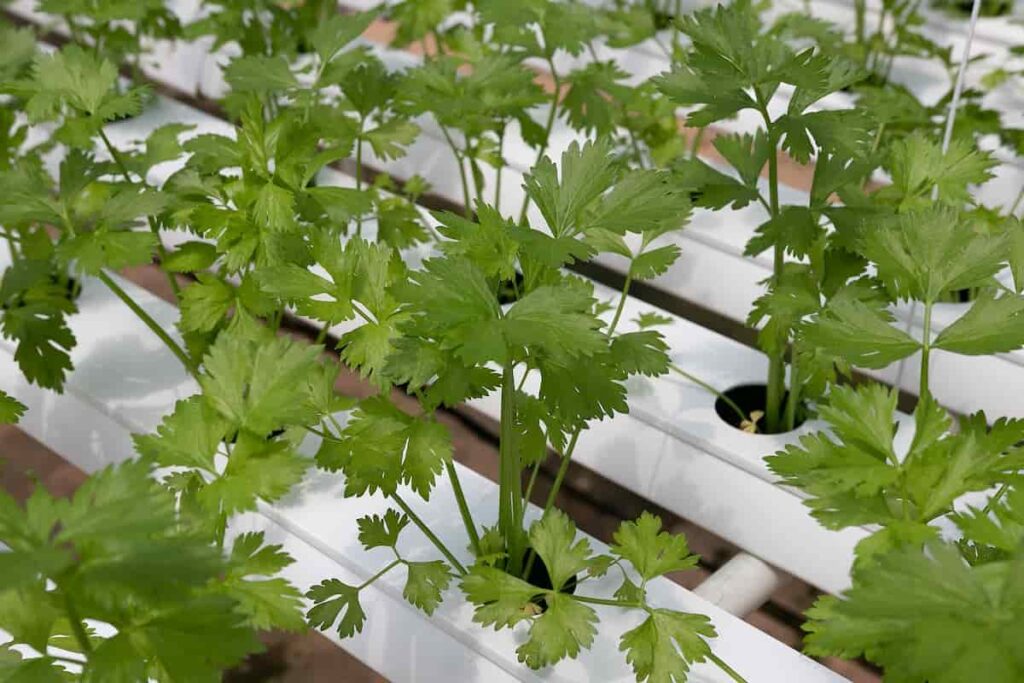
Hydroponic Equipment for indoor vegetable growing
Hydroponic equipment is an essential tool for indoor vegetable growing. Growing vegetables indoors is becoming increasingly popular, as it allows a controlled environment to ensure optimal growth. In addition, having the right equipment on hand can make the process much easier, produce more accurate results, and be more successful.
When it comes to hydroponic equipment, there are several pieces of equipment you will need to set up a successful growing environment. First, a nutrient solution reservoir, pumps, and tubing are necessary for providing the plants with nutrients, oxygen, and water. Additionally, you will need to purchase grow lights to provide the necessary light for your plants. Finally, a hydroponic growing medium, such as Rockwool, cocopeat, or clay beads, is required for your plants.
- Grow Light: Direct sunlight is still the primary source of light for growing plants. Vegetables require at least six hours of light per day to propagate. The best method to germinate seeds is to grow them on windowsills. If you can’t meet this requirement, use grow lights.
- Micronutrients & macronutrients: pre-mixed liquid hydroponic nutrients are now widely available on the market. Nutrients can also be purchased in dry form, typically less expensive. However, before use in hydroponic systems, baking and testing are required.
- Net pots: Slits or holes in the bottoms of these pots allow plant roots to grow. Net pots can be made by cutting holes in plastic cups with open bottoms.
- Medium: Substrates such as coco coir, gravel, peat moss, vermiculite, and perlite can replace soil. The other option is rock wool and hydroton, a clay aggregate that has been expanded in a specific way. Because these substrates do not provide nutrients to the plants, dissolved nutrients in the water are required.
- Water: Use a chemical-free source and avoid chlorine when watering your plants. The best water to use is mineral or spring water. Either way, you can add nutrients to filtered or reverse osmosis water.
- The pH metre of the mineral nutrient solution should be between 5 and 7 to ensure it is neutral. Most plants can absorb nutrient-rich water at pH levels between 5.5 and 6.
In case you missed it: Hydroponic Farming at Home: How to Start, Kit, Cost, Best Plants for Home Hydroponics
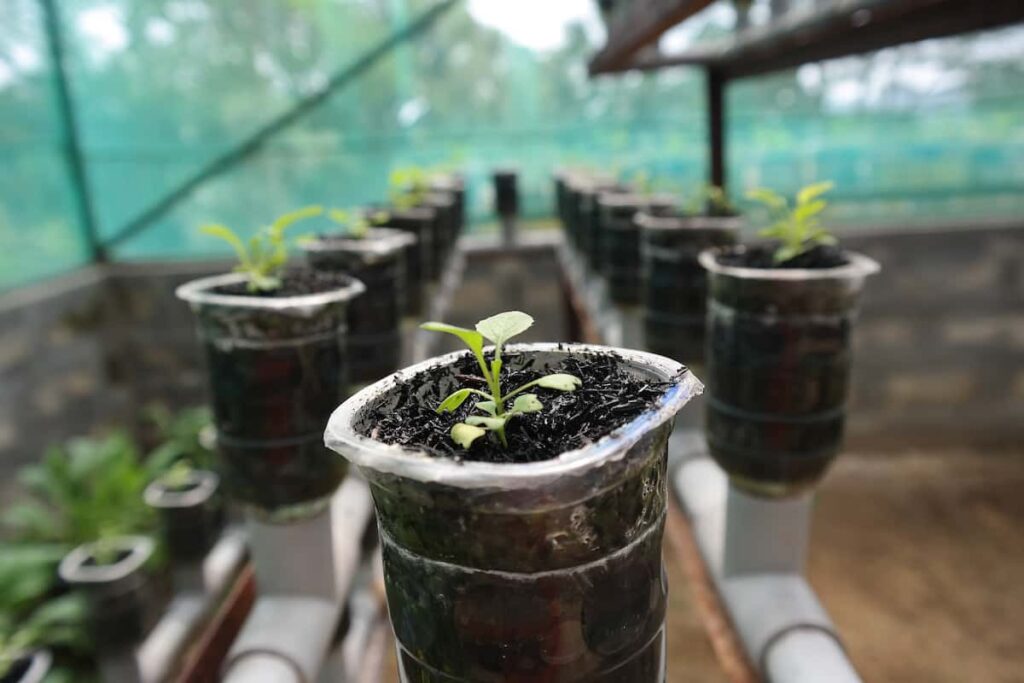
Other tools, such as a water pump and an air stone, can be used in addition to the items listed above. Still, those listed above are the essentials for any hydroponic setup. Once you have all the necessary equipment, you can start to set up your growing environment. Ensure that you take the time to adjust the environment to the needs of your specific plants. Then, with the right equipment and environment, you can start growing vegetables indoors year-round.
The most simple Hydroponic methods to grow vegetables in Indoor
The two simplest DIY hydroponic methods for growing plants indoors are the Kratky Method and the Wick System. These two systems do not require an air or water pump to function, allowing plants to be grown without electricity. The advantage is can quickly move plants around on windowsills.
Kratky Method
Because it is the simplest to set up, a Kratky system is an excellent way to begin hydroponics. The Kratky Method brings the plant’s roots into direct contact with water. Then, water is let into the plant via the Kratky system, gradually decreasing the water level. As a result, plants get the oxygen they require, unlike air pumps and stones.
Large enough for the plant you’re growing. Growing tomato plants, you must almost daily refill a mason jar for it to mature. Despite this, cilantro can grow in a small mason jar without additional water from seed to maturity. Tips for Growing Vegetables in the Kratky Method:
- To avoid drowning, ensure the water container is only half or two-thirds full of water.
- Cover your water container with aluminium foil or use a black container if you notice algae growth.
- Containers should be large enough to accommodate total growth.
- You can add more water if your nutrient water has a high PPM level.
- Large plants can be grown in buckets.
In case you missed it: Vertical Hydroponic Farming: A Growing Trend In Urban Agriculture
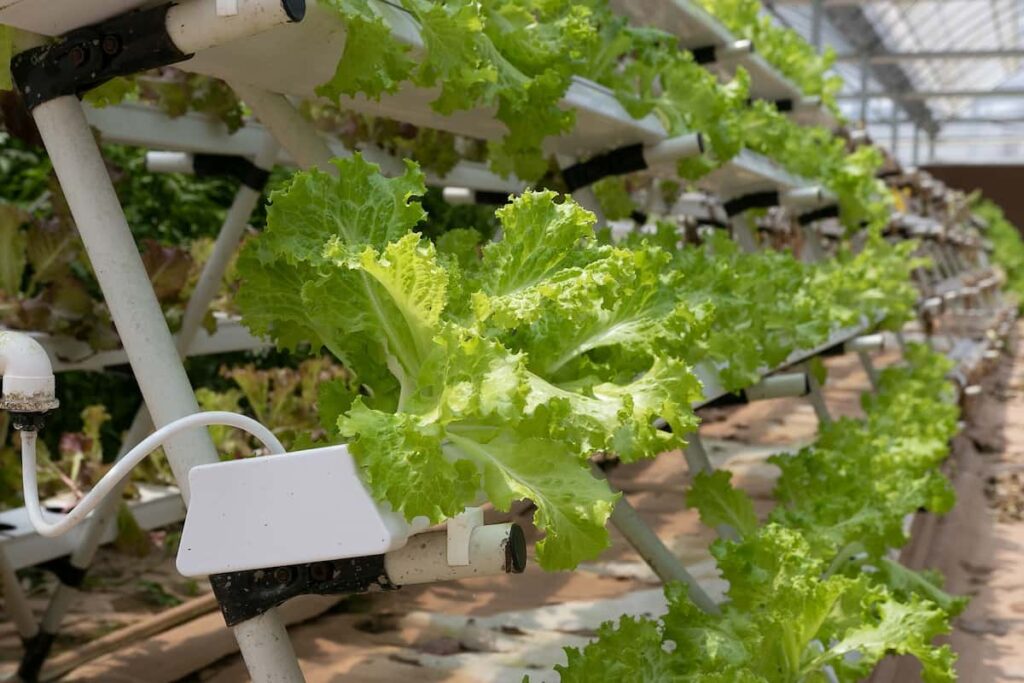
Wicking system
Another simple system is the wick system, which does not require any electric pumps. In wick system works on capillary action to draw water up from a reservoir using wicks such as cotton rope. Using the wick system, plants of different growth cycles can be grown in the same grow tray. Tomato plants do poorly in wick systems because they require more water than the rope can supply. Other Hydroponics Systems for Growing Vegetables in Indoor are as follows:
- Lettuce can be grown using the Nutrient Film Technique (NFT), Deep Water Culture (DWC), and Ebb and Flow systems. If the temperature rises too high, lettuce will bolt and taste bitter.
- The raft system is ideal for lettuce, Spinach and kale.
- Cucumber prefers a pH of 5.8 and an EC of 1.8 to 2. Flood and drain or other bucket-type systems in which plenty of growing medium are best-suited hydroponics systems for Cucumber.
- In hydroponic Indoor, beans can grow using an Ebb and flow; hydroponic system.
Vegetables grown Hydroponically in Indoor
Hydroponic gardening is an excellent way to grow vegetables indoors. With hydroponics, you don’t need soil or large amounts of space. Instead, the nutrients plants need to thrive are provided through a nutrient-rich water solution. As a result, you can quickly grow the vegetables you want with the help of hydroponics growing systems without having to worry about the outdoor environment or soil problems.
- Consider growing your own greens. There are numerous green varieties that will look great in your garden. You have the option of lettuce, Spinach, basil or chives. They can quickly adapt to indoor conditions and thrive without soil.
- Cucumbers perform admirably when grown hydroponically. Bell peppers, tomatoes, and celery will also be favourable to indoor.
- Lettuce, tomatoes, peppers, and herbs are all excellent options for indoor hydroponic gardens. Make sure to check the pH level, the EC level of the nutrient solution, as well as the temperature of the room.
Some types of vegetables will show impressive progress when grown hydroponically. On average, it will take you about 90 days minimum to grow the vegetable. But if you want to start fast and show accurate results right now, opt for the best fast-growing vegetable; fruits are Hydroponically grown fruits, including strawberries, blueberries, and tomatoes. Leafy green vegetables such as Spinach, kale, lettuce, and swiss chard grow quickly in hydroponic systems. Herbs that grow quickly include cilantro, mint, and basil. In 1-3 months, these plants will be ready for harvest.
In case you missed it: Hydroponic Growing System and Gardening
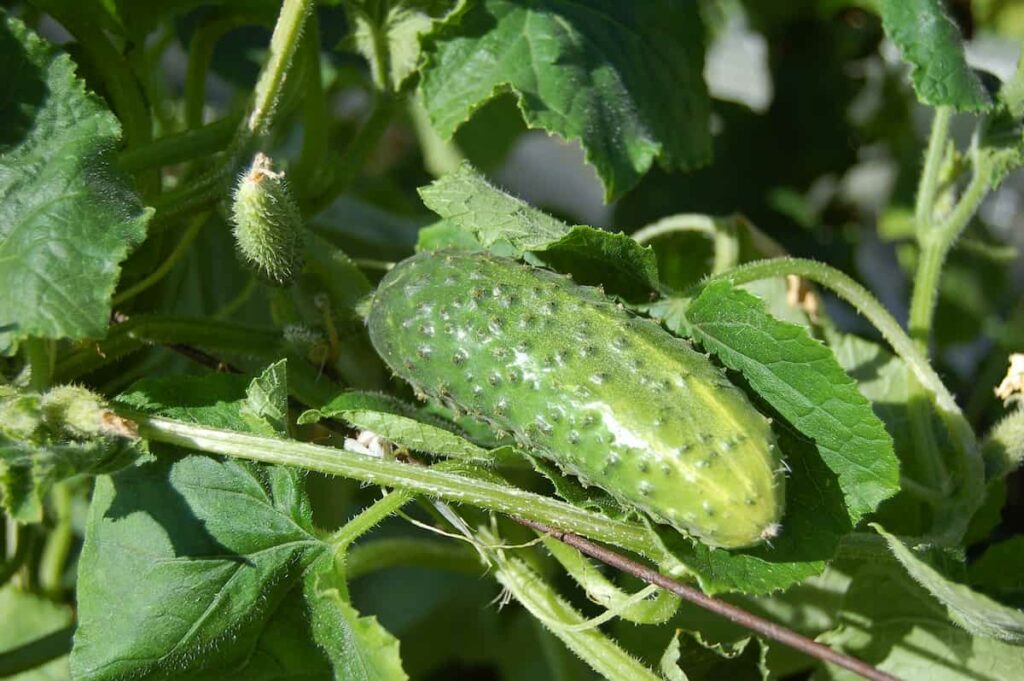
Nutrients for Hydroponic vegetables indoor
Hydroponic vegetables can be grown indoors with the proper nutrients. Hydroponics is an efficient way to grow vegetables indoors, as it does not require soil, saving space and money. The key to successful hydroponic growing is providing the plants with the correct nutrients. Hydroponic systems rely on nutrient-rich solutions to give plants essential minerals, vitamins, nitrogen, and other elements.
Unfortunately, these solutions are usually made up of chemicals and salts. Therefore, solutions should be changed monthly to ensure that all the elements remain balanced. To begin, you must determine how much of each nutrient your plants require. Then, determine whether they can be used in liquid or dry form. You should have detailed instructions from someone who has successfully grown vegetables using hydroponics as a beginner grower.
- The Best nutrients for dwc:Big Bloom, Grow Big, Tiger Bloom Fox Farm Liquid Nutrient Trio Formulation Perfectly formulated for vegetables, fruit trees, and vines. Big Bloom Plant Food is suitable for all flowering and fruiting plants. The formula accelerates the growth process, resulting in delicious harvests from your gardening efforts.
- The Best Hydroponic Tomato Nutrients:Advanced Nutrients Bloom, Micro & Grow This is a three-part nutrient system that has been scientifically designed for high-value plants.
- General Hydroponics has the best hydroponic nutrients for lettuce. Flora Grow, Bloom, and Micro Fertilizer Kit. It contains all essential primary, secondary, and micronutrients for increased yields and crop quality.
When selecting nutrient solutions for your hydroponic vegetable garden, look for ones with high nitrogen, potassium, and phosphorus levels. These are essential for healthy plant growth. Also, check the pH level of the solution – it should be between 5.5 and 6.5.
Making Hydroponic nutrients for indoor vegetable growing
This can be done in either the DWC water reservoir or a separate container before being transferred to your water reservoir.
- Only use cold tap water.
- If you’re using distilled water, add Cal-Mag.
- If your groundwater is cold, use a fish tank heater or immersion circulator to warm it up to 62 degrees Fahrenheit. Water temperatures below 60°F will stunt plant growth.
- Include nutrients. To calculate the nutrient quantity, use this nutrient calculator.
- Add Silica to improve cell wall strength in vegetables only.
- Set the pH to 5.50
- Record pH and EC.
Keep an eye on your nutrient solution to ensure your plants get the essential elements. Too much certain nutrients can cause stunted growth, while too little can result in yellowing leaves. By providing the proper nutrients, hydroponic vegetables can quickly be grown indoors. With the proper preparation, you can have a healthy, thriving vegetable garden right in your home.
In case you missed it: Hydroponic Growing System and Gardening
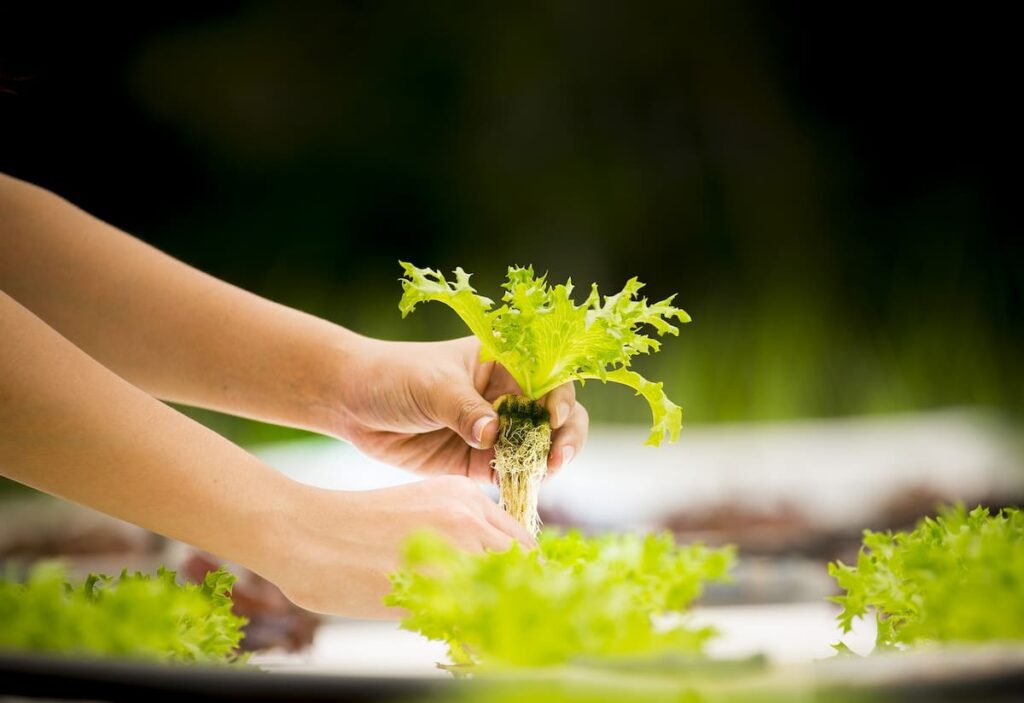
The future of Hydroponic indoor growing
Hydroponic farms provide a path to a more sustainable food ethic that takes priority over the health of our food, bodies, and environment while avoiding harsh chemicals. While our global climate problem is involved and the result of many different practices, reducing the impact of agriculture will be a huge step forward. Hydroponic farming still needed to be invented at the turn of the century.
However, only 20 years later, the industry has gained traction and is already influencing agricultural practices and the future of our food system. Astronauts, explorers, and colonists may one day use hydroponic gardening techniques to cultivate fresh food in space. Hydroponic gardening is a great way to try new things and have a good time. In addition, it’s a great way to add healthy, fresh vegetables to your dinner table.
- Aquaponic Farming at Home: A Step-By-Step Guide
- Profitable Village Farming Business Ideas in 2024
- High-Yield Aquaculture: Fast-Growing Fish for Farming
- Effective Fish Pond Construction Techniques for Beginners
- Irrigation and Water Management in Pineapple Farming
- Blossom to Harvest: Mastering Flowering and Pollination in Papaya Farming
- Pig Fattening Essentials: From Selection to Sale for Beginners
- Raising Wagyu Cattle: A Complete Guide for Premium Beef Production
- Soil Types and Their Water Holding Capacity
- Optimizing Irrigation Schedules for Coconut Groves for Enhanced Yield
- Espresso Your Garden: Coffee Grounds for Healthier Acid-Loving Plants
- The Best Soil Mix for Snake Plants: How to Mix Your Own Snake Plant Soil
- Green Thumb Success: Expert Tips for Cultivating Greenhouse Beans All Year Round
- Bloom All Year Round: The Ultimate Guide to Indoor Hyacinth Care
- Eco-Friendly Gardening: How to Make Liquid Fertilizer from Kitchen Waste
- Ultimate Guide to Grow Anise in Pots: Explore Seed Propagation to Harvesting
- Guide to Raising Chester White Pigs: Discover Breed Facts to Growth Management
- Mastering the Elegance: The Ultimate Guide to Weeping Cherry Tree Care, Planting, and Maintenance
- Ultimate Guide to Planting Garlic in Grow Bags: Growing Strategies for Beginners
- How to Fix Spider Plant Leaf-Related Problems: Natural and Organic Remedies
- 10 Reasons Why Your Tulsi Plant is Shedding Leaves: Home Remedies and Solutions
- Optimizing Growth and Yield: The Advantages of Palm Bunch Ash Fertilizer
- Utilizing Neem Oil Extract as a Natural Pesticide for Hydrangea
- From Soil to Harvest: Various Ways in Which Farmers Can Use AI Tools
- Steps to Encourage and Induce Citrus Flowers: A Comprehensive Guide
- How to Fix Snake Plant Leaf-Related Issues: Natural and Organic Remedies
- Transform Your Garden into a Fragrant Oasis with Raat Ki Rani (Night Blooming Jasmine)
- Discover the Ideal Chicken Breeds for Philippine Farms
- How to Create a Poultry Egg Farm Business Plan for Profits
- Grow Lemon Cucumbers Like a Pro: Insider Techniques for Bountiful Yields
- Ultimate Guide to Caring for Your Pink Princess Philodendron: Tips for Thriving Variegation
- Areca Nut Profit Per Acre: Calculating Yield and Cost of Cultivation
- How Kaveri Chicken is Becoming a More Profitable Breed in Indian Backyards
- Transform Your Barn: 9 Steps to Convert a Horse Stall into a Chicken Coop
- Exploring Suffolk Sheep Disadvantages with Limitations and Challenges
- Guide to Solving Potted Lemon Tree Problems: How to Revive Lemon Tree in Containers
